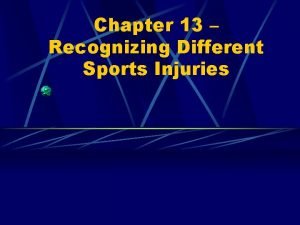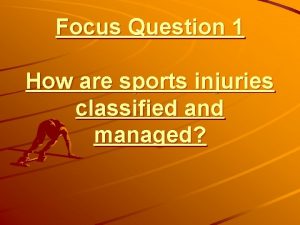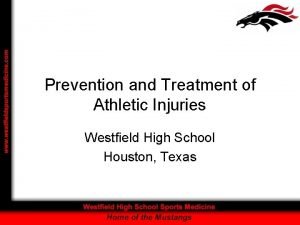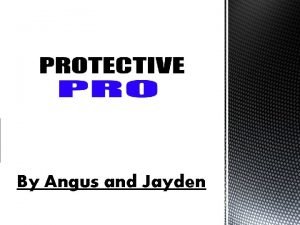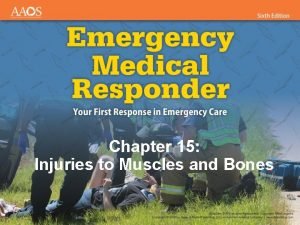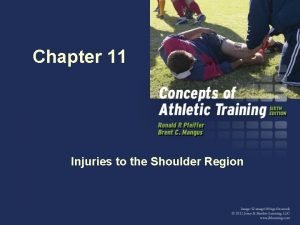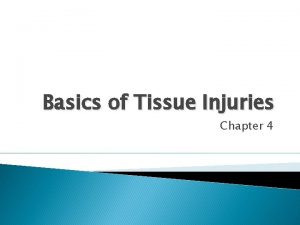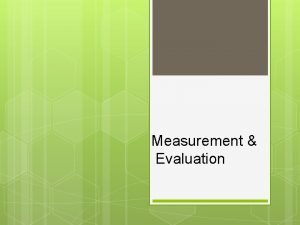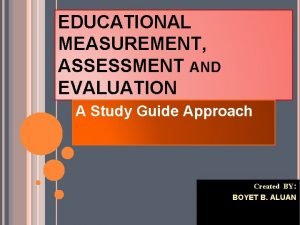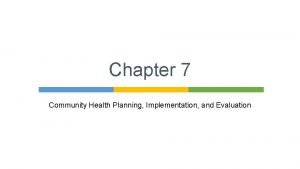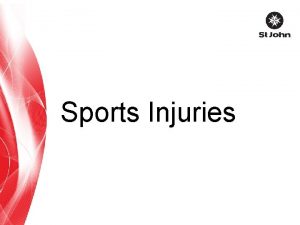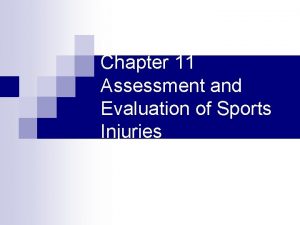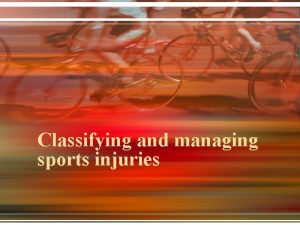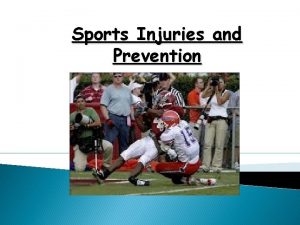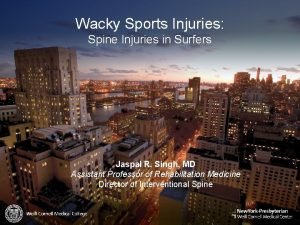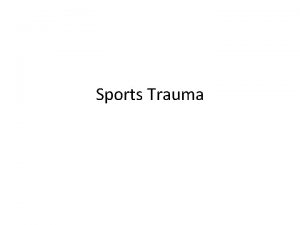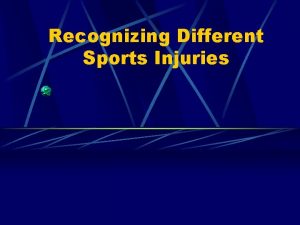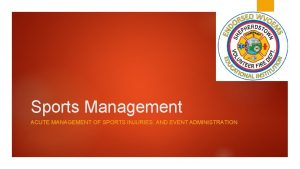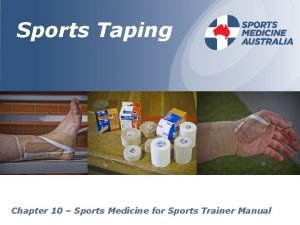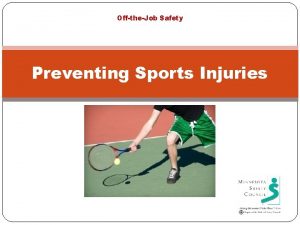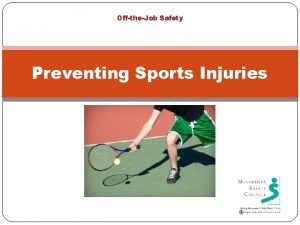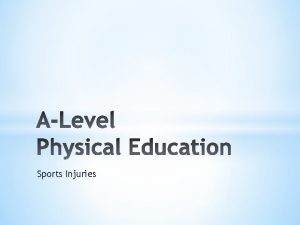Chapter 11 Assessment and Evaluation of Sports Injuries



















- Slides: 19

Chapter 11: Assessment and Evaluation of Sports Injuries

Assessment/Evaluation § An important proficiency for everyone on the athletic care team Copyright © 2004 by Thomson Delmar Learning. ALL RIGHTS RESERVED. 2

Athletic Injuries § Assessment refers to the orderly collection of objective and subjective data on the athlete’s health status. § Diagnosis uses information from the assessment and physical examination to establish the cause and nature of the athlete’s injury; it may be made only by a physician or licensed health care provider. Copyright © 2004 by Thomson Delmar Learning. ALL RIGHTS RESERVED. 3

Factors Influencing Athletic Injuries § Anthropomorphic data, which includes statistics on an athlete’s size, weight, body structure, gender, strength, and maturity level, provides essential information to health care providers. Copyright © 2004 by Thomson Delmar Learning. ALL RIGHTS RESERVED. 4

Factors Influencing Athletic Injuries (cont. ) § Mechanism of force involves an evaluation of all the forces involved at the time of an impact (direction, intensity, duration, activity, and body/ body part position). § Speed at which the injury occurred affects the extent and severity of the injury. Copyright © 2004 by Thomson Delmar Learning. ALL RIGHTS RESERVED. 5

Factors Influencing Athletic Injuries (cont. ) § Protective equipment can reduce the severity of injury and prevent injury. § The athlete’s skill level may also play a role; beginners are more prone to injury than more advanced athletes. Copyright © 2004 by Thomson Delmar Learning. ALL RIGHTS RESERVED. 6

Primary Injury Survey § The first focus of those on the scene of an injury involves assessment of life-threatening emergencies and management of the airway, breathing, and circulation. Copyright © 2004 by Thomson Delmar Learning. ALL RIGHTS RESERVED. 7

Head-Tilt vs. Jaw-Thrust § The head-tilt, chin-lift maneuver should be used to open the airway only if there is no suspicion of spinal injury; otherwise, the jaw-thrust maneuver (right) should be used. Copyright © 2004 by Thomson Delmar Learning. ALL RIGHTS RESERVED. 8

Secondary Injury Survey § A thorough, methodical evaluation of an athlete’s overall health to reveal additional injuries beyond the initial injury. § The HOPS approach is common to the secondary injury survey: History, Observation, Palpation, and Special tests. Copyright © 2004 by Thomson Delmar Learning. ALL RIGHTS RESERVED. 9

Pain Evaluation § A scale can be used to evaluate how much pain the injured athlete is in: 0 1 -3 4 -6 7 -9 10 No pain Minimal pain Moderate pain Severe pain Emergency room pain Copyright © 2004 by Thomson Delmar Learning. ALL RIGHTS RESERVED. 10

Palpation § Palpation refers to touching the athlete during examination to determine the extent of injury. § Palpation should be firm enough to produce pain if injury is present. Too light a touch may result in overlooking a significant injury. Copyright © 2004 by Thomson Delmar Learning. ALL RIGHTS RESERVED. 11

Active/Passive Motion § Active motion is movement by the athlete through the range of motion during examination. § Passive motion is movement done by the examiner through the range of motion while the athlete relaxes the muscles. Copyright © 2004 by Thomson Delmar Learning. ALL RIGHTS RESERVED. 12

Activity § Functional activity refers to the level of movement at which the athlete can comfortably work and participate. § Sport-specific activity involves particular types of movement and actions that are needed in or related to a particular sport. Copyright © 2004 by Thomson Delmar Learning. ALL RIGHTS RESERVED. 13

Return-to-Play Criteria § The athlete must exhibit 100% strength in the injured area. § The athlete must be free from pain. § Skill performance tests must be taken to determine the athlete’s ability to return to play. § The athlete must exhibit emotional readiness to return to the chosen activity. Copyright © 2004 by Thomson Delmar Learning. ALL RIGHTS RESERVED. 14

SOAP Notes § This is a particular format for recording information regarding treatment procedures: – Subjective notes include subjective statements made by the injured athlete – Objective notes include the certified athletic trainer’s visual inspection, palpation, and assessment of active, passive, and resistive motion. Copyright © 2004 by Thomson Delmar Learning. ALL RIGHTS RESERVED. 15

SOAP Notes (cont. ) – Assessment of the injury is the certified athletic trainer’s professional judgment and impression as to the nature and extent of injury. – Plan refers to First Aid treatment rendered and the sports therapist’s intentions as to disposition (what is to be done next). Copyright © 2004 by Thomson Delmar Learning. ALL RIGHTS RESERVED. 16

Daily Sideline Report § Tracks each athlete who participates in a sport § Tracks injuries, missed practices, and limited practice abilities § May reveal injury patterns that should be addressed with the athlete Copyright © 2004 by Thomson Delmar Learning. ALL RIGHTS RESERVED. 17

Training-Room Treatment Log § Anyone receiving attention from the ACT is logged. § Log data includes name, date, injury, treatment provided, and follow-up care required. Copyright © 2004 by Thomson Delmar Learning. ALL RIGHTS RESERVED. 18

Daily Red Cross List § Documentation used to inform coaches of the status of their athletes’ health and injuries. Copyright © 2004 by Thomson Delmar Learning. ALL RIGHTS RESERVED. 19
 Chapter 11 assessment and evaluation of sports injuries
Chapter 11 assessment and evaluation of sports injuries Chapter 13 worksheet recognizing different sports injuries
Chapter 13 worksheet recognizing different sports injuries How are sports injuries classified and managed
How are sports injuries classified and managed Westfield sports injuries
Westfield sports injuries Sports injuries angus, on
Sports injuries angus, on A short backboard or vest-style immobilization
A short backboard or vest-style immobilization Chapter 21 caring for head and spine injuries
Chapter 21 caring for head and spine injuries Chapter 15 injuries to muscles and bones
Chapter 15 injuries to muscles and bones Chapter 14:1 using body mechanics
Chapter 14:1 using body mechanics Jones and bartlett learning
Jones and bartlett learning Chapter 13:2 preventing accidents and injuries
Chapter 13:2 preventing accidents and injuries Chapter 12 lesson 4 fitness safety and avoiding injuries
Chapter 12 lesson 4 fitness safety and avoiding injuries Outdoor indoor sports
Outdoor indoor sports Test chapter 17 first aid
Test chapter 17 first aid Chapter 11 injuries to the shoulder region
Chapter 11 injuries to the shoulder region Chapter 4 preventing injuries through fitness
Chapter 4 preventing injuries through fitness Chapter 4 basics of tissue injuries
Chapter 4 basics of tissue injuries Concept map of measurement assessment and evaluation
Concept map of measurement assessment and evaluation Prognostic test
Prognostic test Community health planning and implementation
Community health planning and implementation

